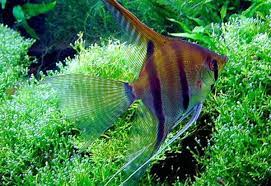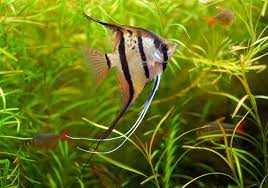Freshwater angelfish, scientifically known as Pterophyllum scalare, are one of the most captivating and sought-after aquarium fish species in the world. These graceful creatures, known for their distinctive triangular shape and vibrant colors, have fascinated aquarists and fish enthusiasts for generations. In this article, we embark on a journey to uncover 55 intriguing facts about
freshwater angelfish, shedding light on their biology, behavior, and the joy they bring to aquarium enthusiasts.

- Majestic Appearance: Freshwater angelfish are renowned for their elegant, triangular body shape and long, flowing fins.
- Origins in South America: These fish are native to the Amazon River basin and can be found in various South American countries.
- Species Diversity: While Pterophyllum scalare is the most common species, there are other Pterophyllum species with distinct features.
- Scientific Classification: Freshwater angelfish belongs to the Cichlidae family, which includes a diverse group of fish.
- Unique Color Variations: They come in various color patterns, including silver, black, marbled, and gold.
- Size Range: Adult Freshwater angelfish typically range from 6 to 12 inches in length, depending on their environment and care.
- Tropical Habitat: Freshwater angelfish thrive in warm waters with temperatures between 75°F to 82°F (24°C to 28°C).
- Distinctive Shape: Their triangular body helps them navigate through thick vegetation in their natural habitat.
- Omnivorous Diet: They are opportunistic feeders, consuming a variety of foods, including small fish, insects, and plant matter.
- Breeding Behavior: Freshwater angelfish are known for their elaborate courtship rituals and pair bonding during the breeding season.
- Egg Layers: They are substrate spawners, laying eggs on flat surfaces like leaves or roots.
- Doting Parents: Both parents actively protect and care for their eggs and fry.
- Longevity: In ideal conditions, angelfish can live up to 10 years or more.
- Community Aquarium Fish: They are generally peaceful but can be territorial during breeding.
- Aggressive Eaters: Angelfish are known for their enthusiastic feeding behaviors.
- Compatibility: They can coexist with a variety of other fish species, but tank mates should be chosen carefully.
- Vegetation Lovers: Angelfish appreciate a well-planted aquarium that mimics their natural habitat.
- Breeding Challenges: Raising angelfish fry can be challenging due to their tiny size and specific dietary requirements.
- Color Changes: Their colors can change in response to their environment, mood, and health.
- Disease Susceptibility: Angelfish are vulnerable to common fish diseases, emphasizing the need for proper care.
- Sensitive to Water Quality: Maintaining clean and stable water parameters is crucial for their well-being.
- Aquascaping Artists: Angelfish are known to rearrange tank decorations to their liking.
- Tank Size Considerations: A minimum of a 20-gallon tank is recommended for a pair of angelfish.
- Social Creatures: They are more active and content when kept in small groups.
- Water Parameter Preferences: Ideal pH levels range from 6.5 to 7.5, and water hardness should be moderate.
- Feeding Habits: A balanced diet of high-quality flakes, pellets, and live or frozen foods is essential.
- Tank Maintenance: Regular water changes and filter cleaning are crucial for their health.
- Egg Care: When breeding, angelfish diligently fan their eggs to ensure proper oxygenation.
- Juvenile Development: The fry undergoes various stages of development before reaching adulthood.
- Hybrid Varieties: Crossbreeding has resulted in numerous hybrid angelfish varieties.
- Aquarium Technology: Advancements in aquarium lighting and filtration benefit angelfish care.
- Historical Significance: Angelfish were first introduced to the aquarium trade in the early 20th century.
- Aquarium Enthusiasts’ Favorite: Their beauty and behavior make them beloved by hobbyists worldwide.
- Aquatic Photography: Angelfish are popular subjects for underwater photographers.
- Scientific Studies: Researchers study angelfish to understand their behavior and genetics.
- Environmental Impact: Habitat destruction in the Amazon basin threatens their natural populations.
- Conservation Efforts: Some organizations work to protect their natural habitats.
- Aquarium Breeding Programs: Captive breeding helps reduce the demand for wild-caught angelfish.
- Aquarium Clubs: Enthusiasts join clubs and forums to share knowledge and experiences.
- International Popularity: Angelfish are appreciated by aquarists in countries around the world.
- Hybrid Varieties: Crossbreeding has resulted in numerous hybrid angelfish varieties.
- Aquarium Technology: Advancements in aquarium lighting and filtration benefit angelfish care.
- Historical Significance: Angelfish were first introduced to the aquarium trade in the early 20th century.
- Aquarium Enthusiasts’ Favorite: Their beauty and behavior make them beloved by hobbyists worldwide.
- Aquatic Photography: Angelfish are popular subjects for underwater photographers.
- Scientific Studies: Researchers study angelfish to understand their behavior and genetics.
- Environmental Impact: Habitat destruction in the Amazon basin threatens their natural populations.
- Conservation Efforts: Some organizations work to protect their natural habitats.
- Aquarium Breeding Programs: Captive breeding helps reduce the demand for wild-caught angelfish.
- Aquarium Clubs: Enthusiasts join clubs and forums to share knowledge and experiences.
- International Popularity: Angelfish are appreciated by aquarists in countries around the world.
- Aquarium Clubs: Enthusiasts join clubs and forums to share knowledge and experiences.
- International Popularity: Angelfish are appreciated by aquarists in countries around the world.
- Breeding Challenges: Raising angelfish fry can be challenging due to their tiny size and specific dietary requirements.
- Color Changes: Their colors can change in response to their environment, mood, and health.



















Add Comment